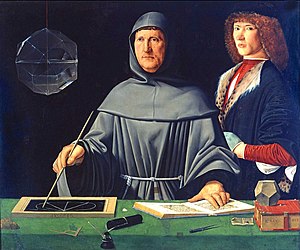Jacopo de’ Barbari
| Data i miejsce urodzenia | ok. 1445 Wenecja |
|---|---|
| Data i miejsce śmierci | przed 1516 Mechelen |
| Dziedzina sztuki | malarstwo, rysunek |
| Epoka | renesans |
Jacopo de’ Barbari, zw. też Jakob Walch (ur. ok. 1445 w Wenecji, zm. przed 1516 w Mechelen) – włoski malarz i rysownik okresu renesansu.
Do 1500 przebywał w Wenecji, gdzie znalazł się w kręgu oddziaływania Alvise Vivariniego, Antonella da Messiny i Giovanniego Belliniego. Następnie wstąpił na służbę do cesarza Maksymiliana I. Okresowo pracował m.in. w Norymberdze, Wittenberdze, Weimarze i Frankfurcie nad Menem. Ostatnie lata życia spędził na dworze namiestniczki Niderlandów – Małgorzaty w Brukseli.
Malował portrety i kompozycje religijne. Był autorem pierwszej samodzielnej martwej natury w malarstwie nowożytnym. Zachowało się ok. 30 jego miedziorytów o treści alegorycznej i mitologicznej, wzorowanych na Albrechcie Dürerze i Lucasu van Leydenie.
Odegrał ważną rolę w popularyzacji zasad renesansu włoskiego w północnej Europie.
Wybrane dzieła
- Błogosławiący Chrystus (1503) – Drezno, Gemaeldegalerie
- Galatea – Drezno, Gemaeldegalerie
- Henryk Meklemburski (1507) – Haga, Mauritshuis
- Krogulec – Londyn, National Gallery
- Madonna z Dzieciątkiem, św. Barbarą, Janem Chrzcicielem i fundatorką – Berlin, Gemaeldegalerie
- Martwa natura z kuropatwą i żelaznymi rękawiczkami (1504) – Monachium, Stara Pinakoteka
- Młody mężczyzna – Wiedeń, Kunsthistorisches Museum
- Starzec i dziewczyna (1503) – Filadelfia, Museum of Art
Bibliografia
- Leksykon malarstwa od A do Z, Warszawa: Muza S.A., 1992, ISBN 83-7079-076-3
- Christine Stukenbrock, Barbara Toepper, Arcydzieła malarstwa europejskiego, Koenigswinter: h. f. ullmann, 2007, ISBN 978-3-8331-2131-9
- Sztuka świata. Leksykon, Tadeusz Barucki, Andrzej Dulewicz (red.), t. 1, Warszawa: Arkady, 1998, ISBN 83-213-4088-1, OCLC 749356630.
Media użyte na tej stronie
It shows Pacioli standing behind a table and wearing the habit of a member of the Franciscan order. He draws a construction on a board, the edge of which bears the name Euclides. His left hand rests upon a page of an open book. This book may be his Summa de Arithmetica, Geometria, Proportioni et Proportionalità or a copy of Euclid. Upon the table rest the instruments of a mathematician: a sponge, a protractor, a pen, a case, a piece of chalk, and compasses. In the right corner of the table there is a dodecahedron resting upon a book bearing Pacioli's initials. An rhombicuboctahedron (a convex solid consisting of 18 squares and 8 triangles) suspends at the left of the painting. The identity of the young man at the right is uncertain, but one commentator recognizes the "eternal student" instructed by Pacioli. Some authors have also mentioned the possibility that the student is Dürer.



